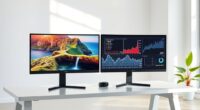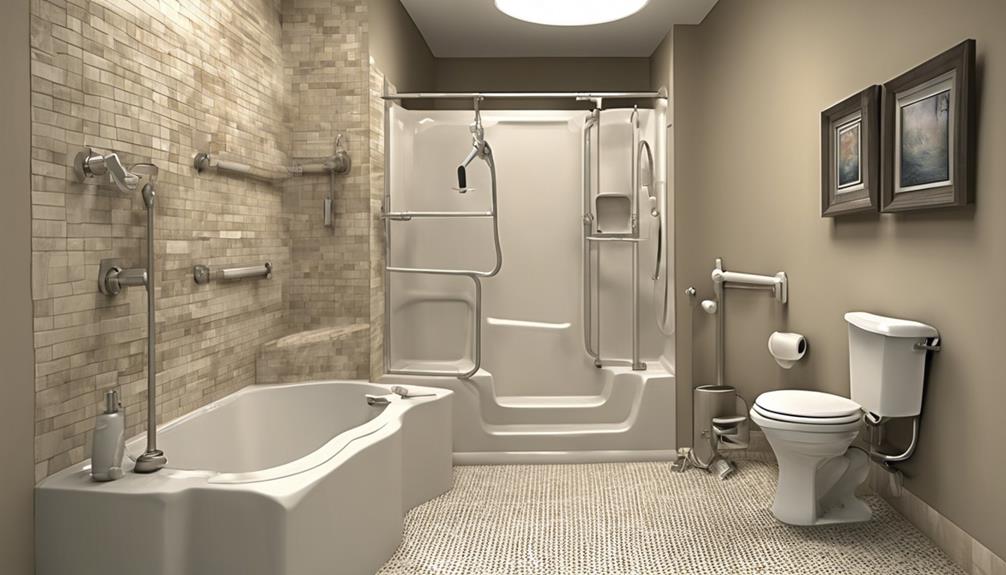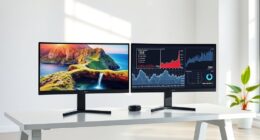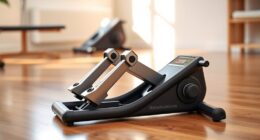If you’re looking for the best photo phones for dementia patients, you’re in the right place! I’ve found some fantastic options that facilitate easy communication and connectivity, like the Clarity P300 and Serene Innovations Amplified phone. They feature large buttons, clear photos, and emergency dial options, which make staying in touch simple and effective. As you explore, you’ll discover more about these models and their unique features to keep your loved ones connected with ease.
Key Takeaways
- Photo phones designed for dementia patients feature large buttons and clear visuals, enhancing usability and reducing dialing errors.
- Many models include emergency SOS buttons and speed dial options for quick connections to family or emergency services.
- Amplified sound and adjustable volume ensure effective communication, particularly for users with hearing impairments.
- Durable, compact designs and easy programming cater to the needs of seniors, promoting independence and safety.
- Popular models like the Clarity P300 PET2 and VTech Amplified Photo DIAL offer specialized features for enhanced clarity and ease of use.
Telephones for Seniors – Picture Memory Corded Landline Telephone
When it comes to choosing the right phone for dementia patients, the Picture Memory Corded Landline Telephone stands out due to its 9 Photo Memory Keys, allowing quick access to loved ones with just one touch. I love how simple it is to program—just four steps in under 20 seconds! With a loud receiver volume and adjustable ringer, it ensures that every call is heard. Plus, the large buttons make dialing a breeze. The hands-free speakerphone feature is fantastic for easy conversations, promoting independence and safety. This phone truly keeps seniors connected with family while considering their unique needs.
Best For: Seniors, particularly those with dementia or visual impairments, who need a user-friendly telephone to stay connected with loved ones.
Pros:
- Easy one-touch dialing with 9 Photo Memory Keys for quick access to calls.
- Loud volume with adjustable settings to accommodate hearing impairments.
- Hands-free speakerphone feature enhances convenience and promotes independence.
Cons:
- Corded design may limit mobility compared to cordless options.
- Basic functionality may not appeal to tech-savvy users looking for advanced features.
- Limited emergency services integration compared to modern smart devices.
Landline Phone for Seniors with Big Photo Buttons
For seniors with dementia or memory issues, the landline phone featuring big photo buttons is an invaluable tool. It offers one-touch speed dial with nine programmable photo buttons, making calling loved ones easy. The large, high-contrast buttons enhance visibility, catering to those with visual impairments. Adjustable volume and flashing light alerts ensure calls are noticed, even in noisy environments. The built-in SOS button provides peace of mind during emergencies. Easy installation means no batteries are needed, and its design reduces confusion for memory-impaired users. With a customer rating of 4.6/5 stars, this phone truly supports seniors in staying connected.
Best For: Seniors with dementia, memory issues, or visual and hearing impairments who need a simple and reliable means of communication.
Pros:
- One-touch speed dial with programmable photo buttons makes calling loved ones straightforward.
- Large, high-contrast buttons and adjustable volume enhance usability for seniors with visual and hearing impairments.
- Built-in SOS button provides quick access to emergency contacts, ensuring safety and peace of mind.
Cons:
- Limited to a wired connection, which may not be suitable for all living situations.
- Lacks advanced features found in modern smartphones, such as internet access or messaging capabilities.
- May not appeal to younger seniors who prefer more tech-savvy devices.
Big Button Phone for Seniors with Extra Loud Ringer
A big button phone with an extra loud ringer stands out as an ideal choice for seniors and individuals with dementia, especially since it allows loved ones to stay connected effortlessly. The nine large picture buttons make dialing easy, and I love that I can customize them with photos of family. The adjustable ringer volume guarantees I never miss a call, while the handset volume can go up to 75+ dB for clear conversations. Plus, it’s built tough, perfect for everyday use. With plug-and-play setup and last number redial, it’s a simple, reliable solution for staying in touch.
Best For: Seniors, individuals with dementia, and those who are visually impaired, seeking an easy-to-use phone for staying connected.
Pros:
- Large, customizable picture buttons make dialing simple and intuitive.
- Adjustable volume settings ensure clear conversations and notifications.
- Durable construction designed for frequent use in a home setting.
Cons:
- Limited to landline use, may not suit those who prefer mobile phones.
- No signal tone for stored numbers may confuse some users.
- Dependence on a stable connection to retain stored contacts.
Serene Innovations Amplified Big Button Landline Phone for Seniors
The Serene Innovations Amplified Big Button Landline Phone stands out as an ideal communication solution for seniors, particularly those living with dementia or hearing impairments. I appreciate its large buttons and an 85 dB loud ringer, which assures calls are never missed. The photo buttons allow my loved ones to easily connect with friends, family, or medical professionals with just a touch. It’s powered through the phone line, making it reliable even during power outages. With its simple operation and customer support, this phone enhances security and independence, making it a fantastic choice for anyone needing extra assistance.
Best For: Seniors, individuals with dementia, and those with hearing or visual impairments seeking an easy-to-use communication solution.
Pros:
- Large buttons and photo speed dial for easy calling.
- Loud ringer (85 dB) ensures calls are heard.
- Operates independently of electrical mains, reliable during power outages.
Cons:
- Limited features compared to modern smartphones.
- May not suit younger users or those familiar with advanced technology.
- Design may not appeal to all aesthetic preferences.
Big Button Telephone for Seniors with Photo Memory
Finding a phone that caters specifically to seniors with memory challenges can be a game changer. The Big Button Telephone for Seniors with Photo Memory features nine large picture memory buttons that make dialing effortless. I love how the large photos and numbers enhance visibility, especially for those with visual impairments. There’s also a clear SOS button for quick emergency calls, providing safety and peace of mind. This phone runs on a landline, so no batteries are needed, and it’s compatible with various environments. Plus, the adjustable volume ensures clear communication for users with hearing difficulties. It’s truly a thoughtful design!
Best For: The Big Button Telephone for Seniors with Photo Memory is best for elderly individuals, especially those with memory challenges, visual impairments, or hearing difficulties.
Pros:
- Easy dialing with large picture memory buttons for enhanced usability.
- Clear SOS button for quick emergency access, ensuring safety.
- Adjustable volume for clear communication, accommodating hearing impairments.
Cons:
- Limited to landline use, which may not suit all users.
- May not have advanced features found in modern smartphones.
- Design may not appeal to younger users or those who prefer traditional phones.
VTech Amplified Photo DIAL Accessory Handset for SN5127 & SN5147
For seniors or individuals with dementia, the VTech Amplified Photo DIAL Accessory Handset for SN5127 and SN5147 stands out with its user-friendly design that combines amplified sound and photo dialing. I love how it allows me to program four frequently dialed numbers, attaching photos for quick recognition. The visual ringing indicator and caller ID announce features help those with hearing impairments feel connected. Plus, the big buttons and large display make it easy to use. With its full-duplex speakerphone, conversations sound natural and clear, making it a perfect choice for staying in touch with loved ones effortlessly.
Best For: Seniors or individuals with dementia who need amplified sound and visual assistance for easier communication.
Pros:
- Amplified sound for clearer conversations, aiding those with hearing impairments.
- Photo dialing feature allows for quick recognition of frequently dialed contacts.
- Large buttons and display enhance usability for seniors or those with visual impairments.
Cons:
- Requires a compatible main phone unit (SN5127 or SN5147) to operate.
- Limited to programming only four contacts for photo dialing.
- May not suit younger users or those without specific amplification needs.
Easyfone T6 4G Picture Button Cell Phone for Seniors and Kids
If you’re looking for a phone that’s incredibly easy to use for seniors or kids, the Easyfone T6 4G Picture Button Cell Phone stands out with its large picture buttons. This minimalist design simplifies calling, allowing direct access without searching through contacts. It includes a handy SOS button for emergencies, ensuring safety by automatically dialing loved ones. The loud speaker is great for those with hearing aids, while the 1050mAh battery offers impressive standby time. Plus, the included charging dock makes recharging a breeze. Overall, it’s a fantastic choice for keeping loved ones connected effortlessly.
Best For: Seniors, users with dementia or Alzheimer’s, and kids who need a simple and safe mobile phone experience.
Pros:
- Large picture buttons facilitate easy dialing without searching for contacts.
- SOS button provides peace of mind by allowing quick emergency calls.
- Loud and clear sound quality is beneficial for users with hearing aids.
Cons:
- Limited compatibility with certain networks (not suitable for AT&T, Cricket, or CDMA).
- Basic features may not appeal to tech-savvy users looking for advanced functionalities.
- Minimalist design may lack some apps or features found in standard smartphones.
Big Button Phone for Seniors with 10 Picture Keys
The Big Button Phone for Seniors with 10 Picture Keys stands out as an excellent choice for dementia patients who need straightforward communication solutions. I love how its design emphasizes simplicity with large buttons and visual aids, making it easy to use. The one-touch dialing feature lets my loved ones connect effortlessly, and the amplified volume ensures crystal-clear conversations, even for those with hearing aids. With a user-friendly interface and programmable memory buttons, it’s ideal for seniors or anyone with vision impairments. This phone truly makes staying connected at home reliable and stress-free.
Best For: Seniors, visually impaired individuals, and those with hearing impairments seeking a simple and reliable communication device.
Pros:
- Large, easy-to-press buttons and visual aids enhance accessibility for users with vision impairments.
- One-touch dialing with 10 programmable picture keys simplifies making calls for dementia patients and seniors.
- Amplified volume ensures clear sound quality, making it compatible with hearing aids for better communication.
Cons:
- Being a corded phone, it may limit mobility compared to cordless options.
- The design may be perceived as simplistic, potentially lacking advanced features some users might prefer.
- The weight of 1.52 pounds may make it less portable for users who wish to move it around the home.
Picture Telephone for Seniors
A picture telephone designed specifically for seniors can make a world of difference for those with dementia or Alzheimer’s. With its humanized design, I can easily replace nine family or friend pictures on the keyboard, helping my loved ones quickly identify who to call. This sturdy, corded phone features pre-stored numbers for emergencies and meal orders, ensuring seamless communication. The adjustable volume, hands-free function, and dual DTMF system cater to various needs. Made from durable, eco-friendly materials, this phone simplifies life, making it perfect for seniors, including those with hearing impairments or memory issues, all while being easy to set up and use.
Best For: Seniors with memory impairments, such as Alzheimer’s or dementia, and those with hearing difficulties looking for an easy-to-use phone.
Pros:
- Simple picture identification for quick dialing of family and friends.
- Durable and eco-friendly design, requiring no batteries for operation.
- Features like SOS one-touch speed dial and adjustable volume enhance safety and usability.
Cons:
- Mixed customer reviews indicate potential quality or satisfaction issues.
- Limited to pre-stored numbers, which may not suit all users’ needs.
- Only available in white, which may not appeal to all aesthetic preferences.
Big Button Amplified Speakerphone Photo Frame Picturephone Speed Dial
Designed specifically for those with cognitive impairments, the Big Button Amplified Speakerphone Photo Frame Picturephone Speed Dial stands out as an invaluable tool for dementia patients. With ten memory keys, it allows for easy one or two-touch dialing, ensuring your loved ones can connect without confusion. I appreciate its wall-mountable design and the bright LEDs that indicate call status. The adjustable volume and built-in speakerphone enhance communication, while the photo-illustrated keys simplify the dialing process. Plus, it connects easily to any landline, making it a practical and user-friendly option for families looking to stay connected.
Best For: Individuals with cognitive impairments such as dementia or Alzheimer’s, and their families seeking an easy-to-use communication device.
Pros:
- User-friendly design with photo-illustrated memory keys for quick dialing.
- Wall-mountable feature allows for convenient placement in accessible locations.
- Adjustable volume settings and built-in speakerphone enhance communication clarity.
Cons:
- Limited to landline use, which may not suit those with mobile-only preferences.
- Average customer rating of 3.0 out of 5 stars may indicate mixed user experiences.
- Requires a standard phone jack, which could limit placement options in some homes.
Corded Big Button Picture Phone for Seniors
For seniors, especially those with visual impairments, the Corded Big Button Picture Phone stands out as an ideal choice among the 14 Best Photo Phones for Dementia Patients. Its large, easy-to-locate buttons make dialing a breeze. I love that it’s powered directly from the phone line, so there’s no need for batteries. The customizable picture memory buttons allow me to quickly connect with loved ones, which is a huge relief during emergencies. Plus, the durable design guarantees it’ll last. With features like adjustable volumes and an SOS button, this phone truly meets the needs of seniors, providing both safety and ease of use.
Best For: Seniors and visually impaired users seeking a reliable and user-friendly landline phone for easy communication.
Pros:
- Large, easy-to-locate buttons designed for visually impaired users, enhancing usability.
- Customizable picture memory buttons allow for quick dialing of loved ones, improving accessibility during emergencies.
- Durable construction ensures longevity and stability, making it a reliable choice for everyday use.
Cons:
- Limited to landline use, which may not suit users preferring mobile communication.
- The design may lack modern features found in newer smartphones, such as video calling or internet connectivity.
- Some users may find the weight of the phone (1.59 pounds) cumbersome compared to lightweight alternatives.
Picture Care Phone with 40dB Amplification
With its impressive 40dB amplification, the Picture Care Phone stands out as an ideal choice for dementia patients who may struggle with hearing. I love how it simplifies communication with features like picture dialing, allowing users to call their ten most frequently contacted loved ones just by tapping their photos. Plus, the phone’s memory retains these numbers for life, even without power. The design is compact and user-friendly, ensuring accessibility for those with hearing or vision challenges. With a 911 call button and various ringer options, it truly provides peace of mind while keeping everyone connected effortlessly.
Best For: Individuals with hearing or vision challenges, especially dementia patients who benefit from simplified communication.
Pros:
- User-friendly design with picture dialing simplifies communication for those with cognitive impairments.
- 40dB amplification enhances sound clarity, making it easier for users to hear calls.
- Memory backup for life ensures important contacts are maintained without power or battery reliance.
Cons:
- Limited to only 10 contacts, which may not suffice for users with larger family or friend networks.
- Compact size might make it difficult for those with dexterity issues to handle comfortably.
- Lack of advanced features may not appeal to tech-savvy users who prefer more modern capabilities.
Big Button Phone for Seniors
Finding the right communication tool can make a world of difference for seniors, especially those with dementia or visual impairments. The Big Button Phone for Seniors is a fantastic choice, featuring large, high-contrast buttons that minimize dialing mistakes. With one-touch dialing for nine contacts, including an SOS button, it offers peace of mind in emergencies. The adjustable volume and hands-free function guarantee clear conversations without hassle. Plus, the flashing LED indicator alerts users to incoming calls, making it user-friendly in various settings like homes or medical facilities. It’s designed to enhance safety and maintain connections effortlessly.
Best For: Seniors and visually impaired individuals who need a user-friendly communication tool with emergency features.
Pros:
- Large, high-contrast buttons reduce dialing mistakes and are easy to see.
- One-touch dialing with 9 programmable buttons, including an SOS for emergencies.
- Adjustable volume and hands-free function ensure clear communication for users.
Cons:
- Limited to landline use, which may not suit all users.
- May require assistance for initial setup or programming of contacts.
- Some users might find the design less modern compared to other phone options.
CLARITY P300 Amplified Corded Photo Phone PET2
The CLARITY P300 Amplified Corded Photo Phone PET2 stands out as an excellent choice for individuals who struggle with hearing loss or low vision, making it particularly suitable for dementia patients. This phone amplifies sounds up to 20dB and features an impressive 75dB+ ringer, ensuring that calls are hard to miss. I love the nine programmable photo memory buttons, which let users quickly dial important contacts just by pressing a picture. The large keypad and high-contrast numbers make dialing simple, while the adjustable volume control and visual ring indicator enhance usability even further. It’s a thoughtful design for keeping loved ones connected!
Best For: Individuals with hearing loss or low vision, including dementia patients, who need an accessible and easy-to-use phone.
Pros:
- Amplifies incoming sounds up to 20dB, making conversations clearer.
- Features nine programmable photo memory buttons for quick dialing of important contacts.
- Large keypad with high-contrast numbers and a bright visual ring indicator enhances usability.
Cons:
- Limited portability due to being a corded phone.
- Requires four AA batteries, which may need regular replacement.
- Customer ratings indicate moderate popularity, suggesting mixed experiences among users.
Factors to Consider When Choosing Photo Phones for Dementia Patients
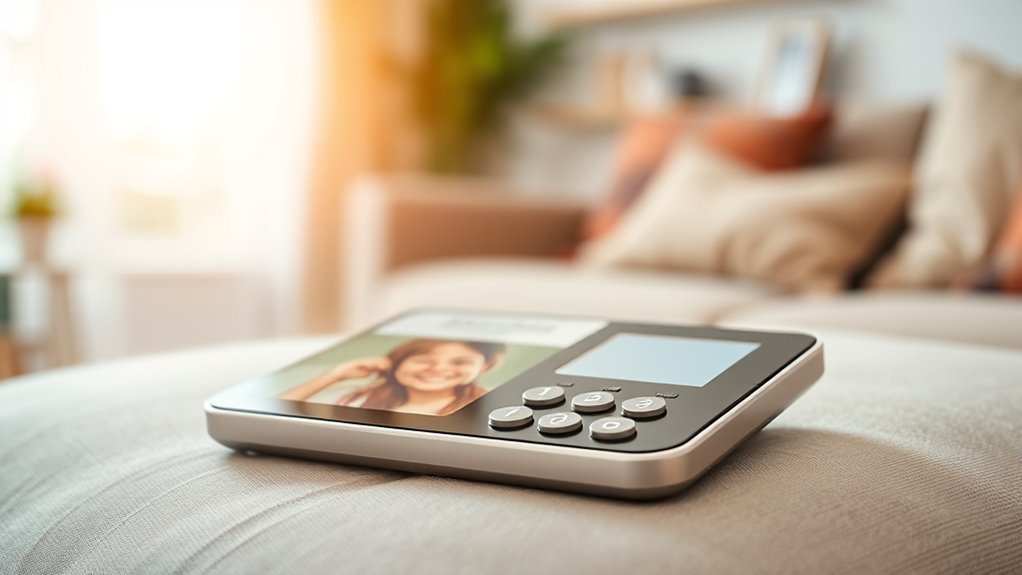
When I look for photo phones for dementia patients, I focus on several key factors. A user-friendly interface and visual memory aids can make a big difference in their daily use. Plus, features like loud ringer volume and emergency call capabilities guarantee safety and ease of communication.
User-Friendly Interface
Choosing a phone for someone with dementia often hinges on the user-friendly interface it offers. I look for devices with large, clearly labeled buttons that make dialing and navigation straightforward. Simplified menus with minimal steps are essential, as they help reduce confusion and ensure operation feels intuitive. I also appreciate visual cues like photos, icons, or color coding, as these enhance recognition and help users quickly identify contacts and functions. A consistent layout minimizes the learning curve, preventing accidental presses. Additionally, clear, audible prompts provide valuable feedback, confirming actions and guiding users through features. With these considerations, I can ensure that my loved ones stay connected without unnecessary frustration.
Visual Memory Aids
Visual memory aids play a crucial role in helping dementia patients navigate their phones more effectively. I’ve found that using large, clearly labeled photos on buttons allows them to recognize contacts easily. By incorporating familiar images of family members or caregivers, we can reduce confusion and improve recall during calls. High-contrast, colorful pictures enhance visibility, which is particularly beneficial for those with visual impairments. Customizable photo buttons let caregivers tailor the phone to match the individual’s specific social connections, promoting independence. Additionally, keeping the placement of photos consistent on designated buttons aids memory retention and minimizes dialing errors. Overall, these visual aids can considerably enhance communication for dementia patients, fostering a sense of connection and ease.
Emergency Call Features
While visual memory aids considerably enhance communication for dementia patients, it’s equally important to prioritize their safety through effective emergency call features. One-touch SOS buttons are a game changer, allowing quick access to help during crises. I love that photo-based emergency dialing lets users contact pre-programmed emergency contacts without needing to remember numbers. Visual alerts, like flashing lights, ensure that emergency calls are noticed promptly, which is vital for those who may not hear well. Storing multiple emergency contacts with photos supports rapid response in urgent situations. Simplified emergency call functions cut down on confusion, making it easier for dementia patients to seek help when they need it most. Keeping loved ones safe should always come first.
Loud Ringer Volume
One of the most vital factors to take into account when selecting photo phones for dementia patients is the loud ringer volume. I’ve found that many of these phones feature ringer volumes exceeding 100dB, ensuring that calls are hard to miss. This high decibel level helps compensate for the hearing loss often experienced by elderly users, markedly reducing missed calls and enhancing safety. Additionally, visual alerts like flashing lights that sync with the loud ringer can be a game-changer for those with severe hearing impairments. Ultimately, a loud ringer volume is essential in preventing missed emergency calls, allowing for reliable communication and peace of mind for both dementia patients and their loved ones.
Adjustable Sound Settings
When selecting photo phones for dementia patients, adjustable sound settings are essential for enhancing communication. I’ve found that having customizable volume levels makes a significant difference, especially for those with hearing impairments. Many phones offer low, medium, and high settings, which cater to varying degrees of hearing loss. The option to turn ringers and handsets off or on helps prevent overstimulation, allowing users to control their auditory environment based on comfort. Some models even provide amplified sound options, increasing audio clarity by 20dB or more for individuals with significant hearing challenges. Easy access to these adjustable sound controls supports independent use and greatly improves communication effectiveness for dementia patients, making conversations clearer and more enjoyable.
Durable Design Materials
Choosing a phone with durable design materials is crucial for ensuring it can withstand the daily challenges faced by dementia patients. I always look for heavy-duty plastics or metal that can handle accidental drops and wear. High-quality, impact-resistant materials are essential; they help prevent damage from rough handling, extending the phone’s lifespan. I also prioritize scratch-resistant surfaces, which keep the display clear and attractive—especially important for devices featuring photo memories. Corrosion-resistant components are a must, as they protect the internal electronics from moisture and environmental damage. Finally, reinforced construction with sturdy buttons and wiring enhances durability, making sure the phone remains reliable for loved ones who need it most.
Speed Dial Functionality
Durable design materials set the stage for functionality, and speed dial features considerably enhance the usability of photo phones for dementia patients. I always look for devices with multiple speed dial buttons, ideally 3-10, allowing quick access to frequently called contacts. It’s vital that each button can be programmed with a photo and corresponding number for easy identification. I prefer phones with one-touch or two-touch dialing to minimize errors and save time. Quick programming of contacts is essential, as it should be simple enough for users with limited technical skills. Finally, I find emergency speed dial buttons invaluable, allowing instant connection to emergency services or trusted contacts. This functionality truly keeps loved ones connected with ease.
Compatibility With Hearing Aids
Selecting a photo phone that works well with hearing aids is vital for guaranteeing effective communication for dementia patients. I always look for phones labeled as “hearing aid compatible,” which indicates they’ll pair well with hearing devices. It’s essential to find adjustable volume controls that reach at least 75dB+, accommodating various hearing impairments. Additionally, I confirm that the phone supports T-coil functionality, allowing hearing aids to pick up sound directly. A loud ringer, also above 75dB, combined with visual alerts like flashing lights, ensures that calls are noticeable. Finally, I verify that the phone’s amplification features don’t interfere with hearing aids, promoting clear and comfortable conversations for my loved ones. This attention to detail makes a significant difference.
Frequently Asked Questions
Are Photo Phones Suitable for Patients With Advanced Dementia?
Yes, I believe photo phones can be suitable for patients with advanced dementia. They simplify communication by using familiar images, which can evoke memories and feelings. I’ve noticed that when I show my loved ones pictures of family or favorite places, it often sparks joy and recognition. While they might not grasp all the technology, the visual cues help bridge the gap, making interactions more meaningful and keeping them connected to their loved ones.
How Can I Customize Photo Buttons for Individual Users?
I customize photo buttons for individual users by selecting clear, recognizable images that represent their loved ones or favorite activities. I use a simple editing app to resize and print these photos, ensuring they’re easy to see. Then, I stick them onto the phone buttons, associating each image with a specific contact. It’s a straightforward process that helps my loved ones stay connected and feel more comfortable using their devices independently.
What Is the Average Battery Life of These Photo Phones?
The average battery life of these photo phones typically ranges from 24 to 48 hours, depending on usage. I’ve found that moderate use, like making calls and viewing photos, usually stretches the battery life toward the upper end of that range. It’s always a good idea to keep the phone charged overnight, though. That way, I’m sure it’s ready for the day, especially when my loved ones want to connect.
Can These Phones Be Used With Hearing Aids?
Like a bridge connecting two shores, these photo phones can indeed work with hearing aids. I’ve found that many of them offer compatibility with various hearing aid models, making communication smoother. It’s essential to verify the specific model’s features, though, as some may perform better than others. I always recommend testing it out to ensure everything works seamlessly, so your loved ones can stay connected without any hiccups!
Are There Any Warranty Options for Photo Phones?
Yes, many photo phones come with warranty options that can safeguard your investment. I usually look for devices offering at least a one-year warranty, covering any defects or malfunctions. Some manufacturers even provide extended warranty plans for additional peace of mind. I recommend checking the specific warranty details before purchasing to ensure it meets your needs. It’s always nice to have that extra layer of protection when trying out new technology.
Conclusion
In conclusion, choosing the right photo phone can truly transform communication for dementia patients. By picking a product that prioritizes simplicity and visual cues, you’re not just enhancing connectivity; you’re fostering fondness and familiarity. Remember, it’s all about ensuring ease and engagement, helping loved ones stay linked with laughter and love. So, let’s make meaningful moments memorable with the perfect photo phone that brightens their day and strengthens those essential connections!

